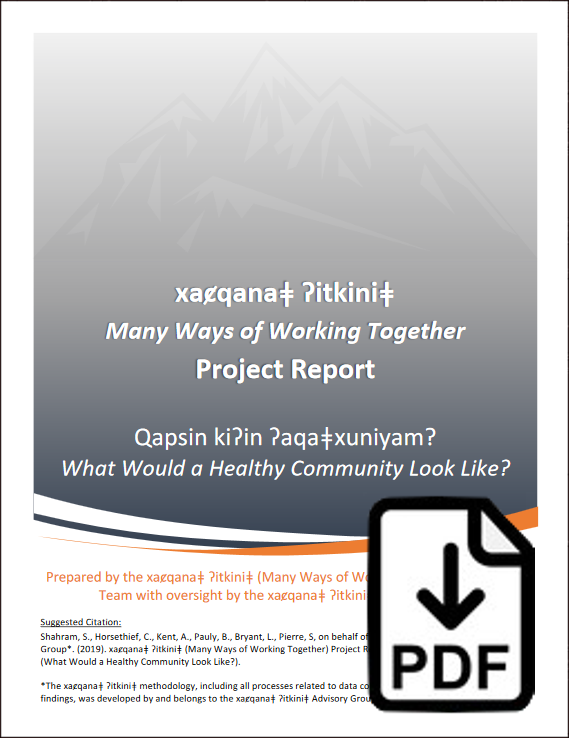Qapsin kiʔin ʔakaǂxuniyam?
What Does a Healthy Community Look Like?
Ktunaxa Community Model of Wellness
Our approach to developing a Ktunaxa Community Model of Wellness has been to work closely with the xaȼqanaǂ ʔitkiniǂ Advisory Group to facilitate community gatherings to hear Ktunaxa Nation Citizens’ ideas in response to the question Qapsin kiʔin ʔakaǂxuniyam? (What would a healthy community look like?). In Fall 2018, we hosted two rounds of community gatherings in Yaqan Nukiy, ʔA·kisq̓nuk, ʔA·kink̓umǂasnuqǂiʔit and ʔAq̓am (eight in total). All Ktunaxa Nation Citizens of all ages were invited to attend the community gatherings for a shared meal; however, only consenting adult participants were included in the data collected during the discussion. In total, 53 community members participated in these lively discussions.
What We Heard and Big Takeaways
Based on participants’ responses to the question, Qapsin kiʔin ʔakaǂxuniyam? (What would a healthy community look like?), the xaȼqanaǂ ʔitkiniǂ Advisory Group identified a number of common themes that represent shared priorities for Ktunaxa communities. In total, 22 overarching themes were identified with an additional 3 added by the xaȼqanaǂ ʔitkiniǂ Advisory Group (25 total). These themes are presented with explanatory quotes from participants and members of the xaȼqanaǂ ʔitkiniǂ Advisory Group in the Phase 1 project report. Some of the most significant themes include themes around connection: connection within families, connection between communities, connection across generations as well as connection through culture and language.
Our big take-away was that there is a need to address the cultural knowledge disconnect where information isn’t flowing well between the most culturally knowledgeable community members (i.e. Elders and Knowledge Holders) and individuals from Ktunaxa Nation involved with administrative and governance discussions as well as external/non-Ktunaxa researchers, professionals and administrators that have very little access to cultural consultants’ input. The same disconnect exists within and across Ktunaxa families, generations and communities, where communication pathways have been severed due to colonial forces. This is critical because a healthy community must be able to solve problems and access, preserve and share cultural knowledge across time and space.
| Key Theme | Sample Quote |
|---|---|
| Self-Determination | “We have to create healthy community for ourselves” |
| Children & Youth | “To have a healthy community we need to look after these [kids] and get them their spirit back… Helping the younger ones become who they’re supposed to become” |
| Respect | “A healthy community is open to anybody and everybody. And being able to speak to each other, not behind people’s backs” |
| Connection & Belonging | “Most important part of a healthy person is to be connected to different people… Connectivity amongst members of the community; that’s where I’m trying to start from; foundation for a healthy community… Healthy community is getting together” |
| History & Ancestors | “What makes us strong, what has come through our roots… our word for ancestors means roots, and our strength comes from our ancestors. Our ancestors hold us together” |
| Purpose & Hope | “If you don’t have hope or you don’t know how to envision, you have a hard time feeling healthy” |
| Culture | “There’s a certain time of year when I do think we have a healthy community: Winter. When we’re all visiting and we’re doing our work. I really look forward to that… It’s ours. It’s Ktunaxa. We define it, the structure of it, how it happens. We all contribute to it. There’s very clear boundaries, but they’re different, they’re Ktunaxa boundaries: who sings and when, how you carry yourself, what you bring, everyone has a role, everyone is participating, even the people that aren’t there are still participating… And there’s an understanding of that” |
| Pride | “A healthy community learns how to celebrate successes, in each other and be proud of what the community accomplishes together… Each individual to be honoured and held up for the things that each individual has to bring” |
| Identity | “Back in the day, you were Ktunaxa first — didn’t matter what community you were from; we all spoke the same language (some a little differently, but it didn’t matter)” |
| Food Sovereignty | “Berry picking — not just about the berries; also sharing and relationships” |
| Elders | “If I had a wish, I’d wish that all the Elders were back, and it would be a happy community again” |
| Family | “To have healthy communities we need healthy families and to have healthy families we need healthy individuals” |
| Spirituality & Ceremony | “A healthy community knows when ceremony is needed and when prayers are needed, and the prayers are honoured and answered” |
| Language | “You listen, and we’ll tell you our stories. We’ll use our language. It’s good to hear that, it makes you feel better” |
| Forgiveness & Healing Connections | “We need to focus on the role of forgiveness on moving on. Especially when we have grievances with other people it’s not possible to move forward without addressing forgiveness. Sometimes we carry patterns on subconsciously, and we don’t even remember why we might be upset. The process of forgiving might cause us to remember, but we have to remember before we can move forward” |
| Genealogies & Familial Connections | “In community, and as a rule, culturally, family relations are understood at regular community gatherings when children are young… Gatherings help families know who belongs to what family and make those connections” |
| Cultural Roles & Behaviours | “If we’re growing up not familiar with these responsibilities we may not create a functional community. That has an impact on community health as well” |

